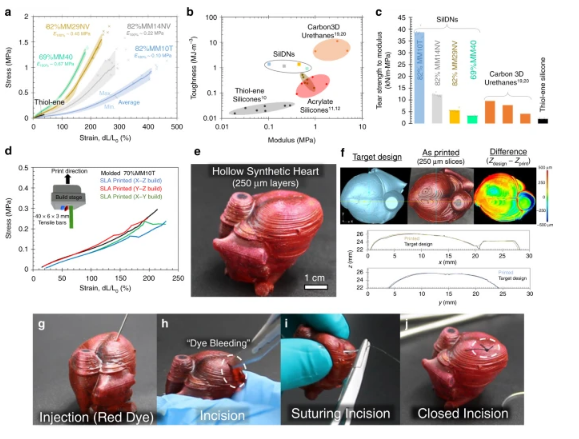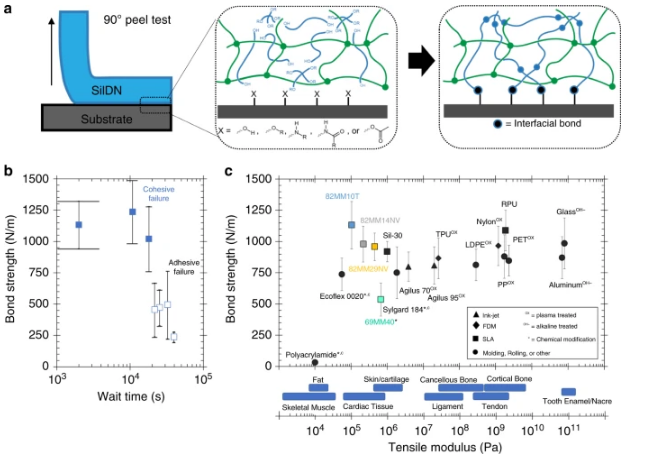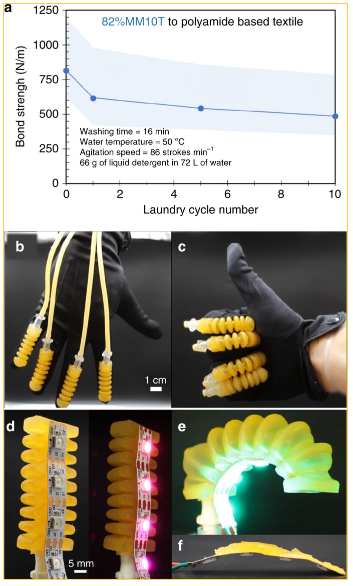The fabrication of soft devices is evolving further, with the completion of recent research performed by US scientists. With the results published in “3D printable tough silicone double networks,” the authors explain how soft materials can be fabricated with micron resolution for complex systems like robotics, as well as new types of wearables.
Soft materials are produced industrially for many applications, with soft matter deployed for shock absorption, conformal requirements, energy recapture and robotics, where devices must be able to deform. Cross-linked materials like silicone rubbers (more formally known as poly(dimethylsiloxanes)) are popular for use due to strong mechanical properties, and temperature and chemical resistance. Most methods for using such materials with traditional techniques like injection molding are extremely limited though, and only suitable for creating basic geometries.
Previous research has shown success with liquid silicone rubber material for 3D printing ink, yielding more complex shapes. Challenges have been noted, however, in terms of structures being printed with overhangs, as well as those with a “high aspect ratio structure,” due to lack of stability like “slumping” before curing. Other experimental techniques have resulted in a lack of resolution, inferior mechanical properties, or slower printing speed.
In this study, the researchers employed the use of a materials platform consisting of silicone double networks (SilDNs), offering low elastic moduli and strength not found in previous SLA elastomers. The printing resin was made up of two different silicones, in which one “weak, but 3D printable silicone network ensnares the precursors” for a stronger form of silicon. Not only does this result in a more mechanically robust elastomer than previously possible, but the material also bonds with a number of substrates—including thermoplastics, thermosets, ceramics and metals—opening up a new range of applications.
“The combination of low moduli, high toughness, and high tear resistance is desirable when printing soft robotic and biomedical devices,” stated the researchers. “Unlike other materials where the 3D printing process can impart anisotropy or alter performance, SilDNs can possess similar properties regardless of print orientation or layer height. These findings suggest that the condensation network crosslinks across printed layers.”
Because soft architectures are required in applications like medical and surgical simulation, the researchers created a hollow synthetic heart model, meant to imitate an infant heart and cardiac tissue as closely as possible. The material exhibited high tear strength, which is critical as medical professionals practice injections, incisions, and doing sutures.
For devices like soft actuators and sensors, a good elastomer-textile bond is necessary, allowing for tear resistance, and the ability to connect to typical textiles, like stretchable fabrics. Wearables must be able to hold up under wear and tear and “donning and doffing cycles.”
Ultimately, the authors recommend the SilDN framework for improving speed and mechanical properties; however, the addition of other chemicals like photo-latent catalysts could be helpful for better control of condensation. Along with that, the network could benefit from greater stiffness and strength.
“SilDNs can also be produced from other condensation networks including those with advanced functionality (e.g., self-healing behavior) to enable a device performance,” stated the researchers.
Materials were 3D printed on an Ember SLA 3D printer, using a blue-light LED projector, modified with a wiper blade assembly for better prints. They also added a dye series to refine Z-axis resolution, and then in post-printing, painted the surgical simulator with SilcPigs pigments.
Silicone is being used in a variety of research projects and applications today, from 4D stretchable fabrics to direct ink writing for metamaterials with shape memory behavior, and use in applications for creating sensors.
[Source / Images: “3D printable tough silicone double networks”]Subscribe to Our Email Newsletter
Stay up-to-date on all the latest news from the 3D printing industry and receive information and offers from third party vendors.
You May Also Like
Precision at the Microscale: UK Researchers Advance Medical Devices with BMF’s 3D Printing Tech
University of Nottingham researchers are using Boston Micro Fabrication‘s (BMF) 3D printing technology to develop medical devices that improve compatibility with human tissue. Funded by a UK grant, this project...
3D Printing Webinar and Event Roundup: April 21, 2024
It’s another busy week of webinars and events, starting with Hannover Messe in Germany and continuing with Metalcasting Congress, Chinaplas, TechBlick’s Innovation Festival, and more. Stratasys continues its advanced training...
3D Printing Webinar and Event Roundup: March 17, 2024
It’s another busy week of webinars and events, including SALMED 2024 and AM Forum in Berlin. Stratasys continues its in-person training and is offering two webinars, ASTM is holding a...
3D Printed Micro Antenna is 15% Smaller and 6X Lighter
Horizon Microtechnologies has achieved success in creating a high-frequency D-Band horn antenna through micro 3D printing. However, this achievement did not rely solely on 3D printing; it involved a combination...
































